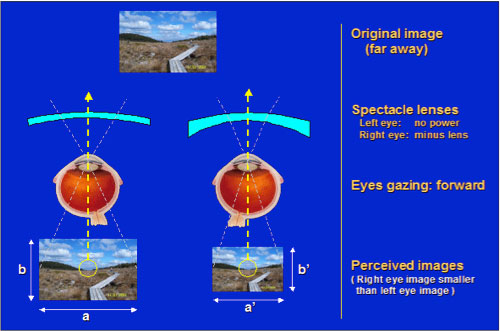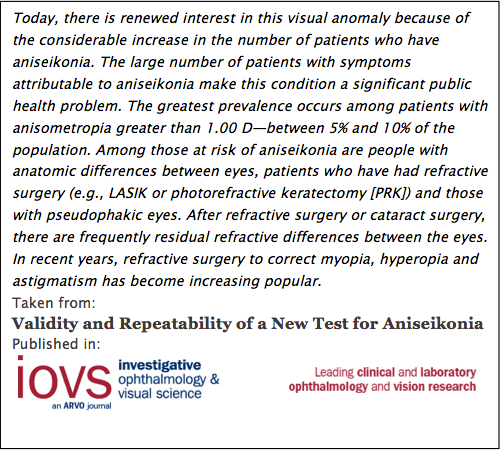Aniseikonia is defined as a difference in the size and/or shape of the ocular images corresponding to each of the two eyes. To make a person see clearly, the images that are appearing on the retina and then transferred to the brain by the optic nerve have to be the same size and overlapping. If the signals or images do not concur, aniseikonia occurs.
Patients wearing glasses with large differences in the prescription for the right and left eye are the most likely candidates to experience aniseikonic symptoms. The large difference in the amount of refractive error is known as anisometropia. An antimetropic Rx is a prescription that has opposite signs for the right and left eye.

|
For example:
OD +2.00
OS -2.00
(OD, occulus dexter, is Latin for right eye, OS occulus sinister, is Latin for left eye.)
The question now is whether the large difference in refractive error, or the spectacles used to correct it, induces aniseikonia. The answer is given by a principle of geometric optics: Any lens placed at the plane of the entrance pupil of any optical system produces no magnification.
If we could place our spectacle lenses at the plane of the iris, they would not produce any magnification. Eyeglasses need to be carried on the nose and need to leave a certain space for the eyelid to open and close. Therefore, the glasses correcting for the large difference in refractive error, and not the refraction itself, are responsible for the aniseikonic symptoms.
However, these symptoms only occur when the patient can achieve binocular vision.
The weaker eye has to achieve a visual acuity of 20/60 or better. Aniseikonia is caused by the difference in image sizes produced on the retina. To notice the difference, both eyes have to be able to recognize it. If one eye sees clearly, the other very blurry, the brain will only accept the clear image, only one image, no magnification difference.

|
Identifying Anisokonia
The first step is to look at the Rx. A large difference between the right and left eye might be an indication. An example for an anisometropic Rx would be
OD +1.00
OS +5.00
A difference of 4 diopters would certainly raise suspicion. To simplify the calculations for astigmatic Rxs, the spherical equivalent is used. To get the spherical equivalent, the amount of cylinder is cut in half and added to the spherical value.
For example
OD +2.50 +0.50 x 090
OS plano +5.00 x 090
The spherical equivalents are
OD +2.75
OS +2.50
and it is not an anisometropic Rx.
The patient’s complaints will give further indication of aniseikonia being present. Headaches, eyestrain, reading difficulties, dizziness and photophobia are possible signs, or the patient might state, the glasses just “don’t feel right”. In two patients with the exact same prescription, these statements might not be the same, because tolerance for magnification differences is subjective. Therefore, just seeing an anisometropic prescription alone does not indicate aniseikonia. Many patients have adjusted to large magnification differences over the years. The glasses for those patients should be more or less a duplication of their current Rx. Same frame style, same frame size, same vertex distance, same base curve, same lens material and same lens thickness. Any changes might result in problems with the new eyewear.
 |
A very small percentage of patients will be symptomatic for refractive aniseikonia. And unless contraindicated, contact lenses are always the treatment of choice for aniseikonia when it is caused by anisometropia. Therefore, an optician will not have many opportunities to practice designing iseikonic lenses. However, the knowledge and understanding of how to treat aniseikonia with spectacle lenses will identify the expert optician.
Look for Part Two of Design of Iseikonic Lenses...

|
Since she came to Florida in 1987, she has worked diligently to promote high professional standards in opticianry. Her mission is to help opticians achieve their personal success through serving the public as vision experts.
As a professional development coach Maggie provides education workshops that focus on leadership and personal engagement. Her time management course has inspired many participants to think outside the box, apply newly acquired knowledge and achieve extraordinary results.
Maggie's enthusiasm for opticianry is inspiring and her keen business sense paired with excellent communication skills make her a highly sought after motivational speaker.













